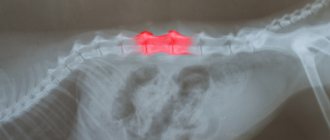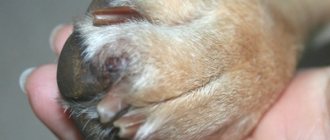Quite often, dogs experience a persistent weakening of hearing up to its complete absence - deafness. This pathology is a violation of the perception of sounds of the surrounding world. Sudden hearing loss and progression of pathology cannot escape the attention of the owner, since in this case the pet’s behavior changes significantly. The dog, who previously obeyed unquestioningly, responded to his name, and was frightened by fireworks, suddenly ceases to understand commands, does not respond to a familiar voice, and becomes indifferent to the sounds of fireworks. Such changes clearly indicate a sharp decline in the quality of hearing, and this cannot leave the owner indifferent. Why did this happen, how to recognize deafness and what needs to be done in such a case? We will examine these questions in this article.
Types of hearing loss
Deafness in dogs can be congenital or acquired. In the first case, it is almost impossible to help the animal.
Hearing loss resulting from injury or illness is treated depending on the severity of the condition.
Congenital
Puppies begin to respond to sound starting from the 10th day of life. If the baby sleeps peacefully, not paying attention to clapping or loud voices, and does not react to sharp sounds, congenital deafness is suspected.
Acquired
As a dog ages, it gradually loses its hearing. The owner may not notice this.
Breeders most often pay attention to situations when the animal does not react at all to any sound stimuli.
Deafness that develops over the course of a lifetime is difficult to notice and identify. This pathology does not cause pain in the pet, he gets used to his condition, his behavior does not change.
Prevention measures
The main preventive measures are as follows:
- From an early age, it is important to maintain hygiene of the ears and canals, cleaning them as necessary.
- Regularly take your pet to the veterinarian for a preventive examination of the condition of the hearing organ.
- Avoid frequent hypothermia, which can cause otitis media.
In addition, before purchasing a puppy, you should always ask the breeder whether its parents had hearing impairments. This is especially true for representatives of certain breeds and merle dogs that are predisposed to congenital deafness. It is also worth checking the baby's hearing status. To do this, make a loud sound (for example, slamming a door). Lack of response is a clear indication that the dog has very poor hearing.
Definition of deafness
There are signs by which it is easy to determine that an animal will lose its hearing. By monitoring the pet's behavior, their ability to pick up sounds is determined .
Reaction to sound stimuli
There are sounds to which a dog always reacts.
This is the voice of the owner, the barking of stray dogs outside the window, the opening of the refrigerator door, a knock or bell on the front door, the click of a lock. If the dog completely ceases to show interest in these sounds, deafness is suspected.
Review of the nickname
From a young age, the puppy remembers its nickname and reacts violently to this word. If a dog does not respond to its owner's call even at close range, it has hearing problems.
Tranquil sleep
Even in sleep, a healthy dog can hear well what is happening around. It is not for nothing that these animals are considered the best guards.
A dog with hearing problems does not react during sleep even to loud sounds, such as clapping, screaming or the fall of a heavy object.
Activity
A sick animal refuses to play, most often sleeps, not reacting to environmental stimuli or surrounding noises. You can wake up a dog only by touching, not by calling.
Passivity while walking
When the hearing level decreases, the dog on the street becomes anxious.
She clings to her owner's feet, refuses to leave his side, turns her head around, trying to discern a possible threat. A sick animal is no longer interested in outdoor games.
Fear of touch
A dog with developing deafness may not hear when a person approaches him. If the owner is out of sight of the pet and unexpectedly touches it, the animal will flinch in surprise.
Shaking your head
Hearing problems in dogs are a consequence of diseases.
If your pet shakes its head frequently or constantly scratches its ears, this is the first sign that your pet needs to be checked for ear infections by a veterinarian.
Disorientation
A deaf dog has poor spatial orientation and may turn in the wrong direction or lose its balance.
Change of emotions
A sick animal exhibits excessive agitation and uncharacteristic behavior.
Tips for caring for and maintaining a deaf dog
It will take some time and a lot of patience to establish normal life again with an animal that has lost hearing. It is not so much the dog that must retrain as its owner. For example, a very “old” animal strives to reduce its once active lifestyle to a passive and comfortable one. Such a dog will not experience significant anxiety with complete or partial hearing loss. The owner is obliged to do everything possible to help the pet adapt to the new realities of his life.
Sometimes the owner is deceived and thinks that the hearing has improved. For example, a dog may not react to the shaking of the floor, but to the sound of footsteps itself. Therefore, it is better to help your dog adapt by following a few simple recommendations.
- It is necessary to monitor the dog so as not to accidentally harm it. The pet may get confused underfoot, lie in the wrong place, or interfere with work. Deafness will not allow him to hear the sounds around him and correctly assess the impending danger.
- A deaf dog should not be left outside on its own without supervision. She is only taken for walks and outside with a leash. Running freely is allowed only in a fenced area or in places where nothing poses a threat to health. You can walk with your pet in a field or in a well-visited park area where there are no other aggressive animals.
- A dog with a hearing impairment needs daily training. Teach her to respond to your movements, teach her to understand your gestures. They are highly trainable and will soon be able to understand your commands through visual contact.
- Use tactile contact with your pet when leaving or arriving to let the animal know. Use the same method to wake up your dog and invite him to eat.
- Be sure to attach a bell to your dog's collar when going out for a walk. The dog can get lost, and calling it is useless. The location of the animal can be determined by the sound of the bell. These days, electronic tracking sensors can be used. Using them, you can track the movement if the animal gets lost.
A dog's deafness is not a death sentence for the animal. Help your four-legged friend better adapt to new conditions. Love, care and patience will help provide your pet with a comfortable and happy life.
Currently reading:
- Seven Signs and Remedies for Getting Rid of Fleas in Dogs
- What to do if your dog has an abnormal bite
- Games to choose for training a dog
- 6 Causes of Red Ears on the Inside of Dogs
Deafness test at home
You can determine if your dog is deaf at home.
The dog is a good watchman, and at the same time she has a very sensitive sleep. After the animal has fallen asleep, you can clap your hands loudly, drop a metal object, a bunch of keys, or call the pet by name.
A healthy dog will immediately respond to these stimuli. An animal with a hearing disorder will continue to sleep peacefully.
Deafness in a puppy is more difficult to determine. Most often, he is more aggressive than other individuals from the litter, since he does not hear the squeal of his brothers when they bite. It is also difficult to determine whether a deaf puppy will bark. Over time, he will begin to make sounds, but it will sound like a squeal or howl.
How to teach a deaf pet to live a full life
When a dog loses its hearing, it doesn’t matter what caused it: old age or illness. There is only one thing left - to teach your pet to cope with the illness and live a full, rich life with him. Faced with a similar problem, many people panic, not knowing what to do or what to do. But not everything is as bad as it first seems to the desperate owner.
The dogs are very trainable. They understand not only sound, but also sign language and facial expressions, even to a greater extent. You just need to put in a little effort to find the right points of contact.
Here are some points that will help you find common ground:
- In no case should you show weakness, regret or make concessions to your pet. This will only cause you harm. These cunning tails quickly feel and understand when they can, as they say, “sit on the neck.”
- Just like with a healthy dog, you need to be consistent in training with a hearing-lost pet. If you give a command, then it must be executed.
- Raising a deaf pet should be based on gestures and facial expressions. The dog gets used to gestures no worse than to normal communication. Regular commands won't help here. You can borrow some points from literature or training videos. And you can come up with some gestures together with your dog, and they will be understandable only to the two of you:
For example, when you are unhappy, a “no” gesture can be shown by shaking your head. But the gesture of “approval” can be shown by clapping your hands. In order for your pet to follow the command “Sit!”, point your index finger at him and point to the place where the dog should sit.
A pet who is just starting to train needs to be shown what you want from him. It is imperative to monitor the progress of command execution. Teach your dog to pay attention to your facial expressions, teach him to look straight into your face.
Sit in front of your pet, show him a piece of treat, let him smell it. Then bring the treat to your face. The dog will closely monitor your movements. As soon as she looks away from the treat and looks at you, praise her and give her the treat.
This needs to be done many times. Then you should increase the time between showing the treat and bringing it to your face. Take the treat in your hand and show it to your pet, but don’t bring it directly to your face. Having become accustomed to the fact that after you show a treat, you bring it to your face, the dog will immediately turn its gaze to you. After this, immediately bring the treat to your nose, and then smile joyfully, praise the four-legged animal and give it a well-deserved treat.
Be sure to praise your pet for obedience and following commands. Express approval with a glance, a smile and some specific gesture. Be sure to hug your tail and rub his ear. The dog needs to see your emotions, it needs to know that the owner is happy.
- If you are on a walk, under no circumstances walk near construction sites, roads or railways. Never walk your pet without a leash. A deaf, free-ranging animal, carried away by smells, simply will not hear the sound of approaching danger.
- The dog must have a tag on its collar. You need to indicate your phone number and nickname on it; Be sure to write that the dog is deaf.
- When walking in the dark, take with you some luminous object: a flashlight, a luminous bracelet. The dog must understand that you are nearby.
- In addition to facial expressions and gestures, another important way to communicate with a deaf pet is touch. But you need to get used to this gradually, otherwise an unexpected touch may frighten a deaf pet, he may become confused and bite you.
- Before waking a sleeping pet, place your hand near its nose. But under no circumstances touch his face. When your dog smells you, it will wake up.
- When walking outside, touch your dog from time to time. After she turns to you, give her a treat.
Any touch should be associated with pleasure and joy, and not with fear.
- If you are going somewhere, touch the animal. The dog must see that you have gone somewhere, so that later he will not be nervous because the owner suddenly disappeared.
- Having lost hearing, especially at first, the animal feels vulnerable. Organize the four-legged sleeping place in such a way that no one can disturb him again.
- Warn children and guests not to disturb the pet again or run past it.
- A deaf dog may become very frightened if you suddenly catch his eye. To warn of your approach, clap your hands loudly. With hearing loss, the animal's other senses become more acute. Cotton creates a vibration that pets who cannot hear feel very well.
- If you live in a private house, make sure that the entire area is securely fenced. A deaf pet should be safe, especially if you are not nearby.
Examination in the clinic
Only a doctor can make a more accurate diagnosis and identify the cause of hearing pathology.
The animal should be taken to a veterinary clinic for a comprehensive examination.
Testing reactions to sounds
The veterinarian performs a sound stimulus test to check whether the animal can hear at all and what its level of hearing is. The actions are the same as those the owner carried out at home. Various loud and not very loud sounds may be heard at a close distance from the animal.
Otoscope examination
If deafness is suspected, it is important to make sure that the animal’s hearing organs do not have pathologies.
The doctor conducts an examination with an otoscope, identifying deformities, foci of infection, and injured tissue.
X-ray, MRI
Instrumental examinations are considered more effective. They allow us to identify malignant and benign neoplasms, the consequences of internal trauma to the head and ears.
Such a study is always informative and allows for an accurate diagnosis.
Neurological examination
This diagnostic method identifies pathologies of the auditory nerve. Any changes in its tissues threaten complete loss of hearing in the animal.
Electronic examination BAER test
This method is recognized as the most informative in the world. It is given to dogs starting from one month of age.
Test conditions
The test is performed in specialized clinics equipped with the necessary equipment.
The dog must be over 35 days old. An examination is prescribed if no abnormalities were detected during examination with an otoscope.
Preparation
The dog must be completely calm during the procedure; this can be achieved by administering small doses of anesthesia.
To avoid unpleasant consequences, the animal is not fed 10 hours before the procedure. This way he won't vomit under the influence of drugs.
Process
Each ear canal is examined separately. A special earphone is inserted into the animal's ear, which emits various sound signals. They may differ in volume, power, and playback frequency.
At this time, a special sensor reads the brain’s reaction to stimuli.
Duration
The entire examination takes no more than 15–20 minutes. During this time, the computer provides an accurate test result checking the right and left ear canals.
Price
The price for electronic examination varies from veterinary clinic to veterinary clinic. On average throughout the country, this amount does not exceed 2,000 rubles.
Acquired deafness: treatment
After determining the exact cause of your dog’s hearing loss, they immediately begin choosing treatment tactics. Depending on the pathology, antibacterial or anti-inflammatory drugs are prescribed.
Ear blockage
How to treat: mechanical or medicinal cleaning. Use products that dissolve earwax.
To avoid complications, the procedure is entrusted to a specialist. Subsequent cleanings can be done at home with instructions from your healthcare professional.
Inflammation
The suppuration is washed with antiseptics, and antibacterial drugs are prescribed. During the treatment period, it is better not to let the animal go outside, avoid unnecessary physical activity and drafts.
Age-related changes
As your dog ages, he may gradually lose his hearing. This process is irreversible and cannot be treated. The owner needs to learn how to communicate in a new way with an old friend who suffers from hearing loss.
Adapting to your dog's daily routine
A dog with hearing loss may become afraid of approaching people or animals. Training will help soften the auditory startle reflex. During training, give your pet healthy treats - this will be a good motivation for him. Start by approaching your dog from different places, offering him a treat as you approach. Next, try waking your dog (in this situation, he can become very scared), but do it gently - and immediately give him a treat. A smart way to wake up a dog who can't hear is to walk vigorously (so he can sense your approaching footsteps) on the floor next to him or to gently tap his bedding.
Causes of deafness
Hearing loss in dogs can be congenital or acquired.
Some breeds are predisposed to developing ear diseases - spaniels, sharpeis, and terriers. Their ears are larger than those of other animals and are in a hanging position, so inflammatory processes more often develop in the ear canals.
Genes
Animals with hearing problems are not allowed for breeding. Hearing loss is inherited. Healthy parents may have a deaf puppy. In this case, the entire litter is discarded and sterilized.
It is possible to raise a puppy with deafness. His behavior will be no different from his healthy peers. As a rule, dogs that are deaf from birth develop better vision and sense of smell.
A child with pathology learns to respond to gestures and can be trained. An ultrasonic whistle is used in the education process.
Otodectosis
This disease is caused by microscopic ear mites.
In advanced cases, the animal faces complete deafness. It is important to regularly clean the ear canals with special preparations, especially for dogs with “problem” ears: poodles, beagles, spaniels.
After the procedure, acaricides are used - drugs that destroy ear mites in dogs.
Meningitis
Due to bacterial, viral and fungal diseases, the dog develops meningitis - inflammation of the lining of the brain. The pathology affects the deep parts of the organ, disrupting neural connections.
If the disease is not detected and treated in time, the dog may remain blind and deaf.
Otitis
This is inflammation of the ear canal. It is accompanied by sharp pain and occurs due to hypothermia, fluid stagnation after water procedures, infectious diseases, and improper ear cleaning.
Damage to the eardrum
The causes of the problem are injuries. Leads to the development of middle ear infections and complete hearing loss .
Ear cropping by a non-professional
Hearing impairment occurs in breeds whose standard requires the complete absence of ears. If the procedure is carried out incorrectly, over time the ear canal becomes overgrown and the animal becomes deaf.
Canal blockage
Pathology occurs due to the entry of a foreign body into the ear canal, accumulation of wax and dirt, and an inflammatory process.
Only a veterinarian can clean the ear canal.
Animals with predisposition
The risk group includes animals born from deaf parents. In addition to genetics, breed affects the likelihood of developing the disease. Most often, pathology is diagnosed in:
- Dogo Argentino;
- English and American bulldogs;
- terriers;
- beagles;
- cocker spaniels;
- Labradors;
- Dalmatians;
- marbled dachshunds;
- German shepherds and bobtails;
- boxers.
The color of the animal is no less important. Those with white pigmentation on the ears and head are more likely to be born deaf than their black-headed counterparts. This also includes albinos.











